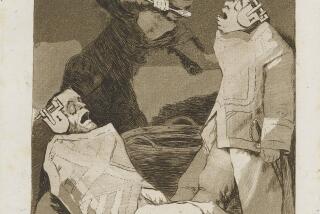The Face of Mayan America : LIVING MAYA<i> text by Walter F. Morris; photography by Jeffrey Jay Foxx (Harry N. Abrams: $40; 226 pp., illustrated) </i>
- Share via
The name Maya is usually associated with peoples who lived in the southern Mexican states of Chiapas and Yucatan and in Guatemala approximately 2,000 years ago, and who left behind magnificent archeological sites as testimony to their intellectual and artistic view of the world and its relation to the cosmos. Reminders of a remote and mysterious past, the grandeur of these ruins often overshadows the existence of the people living today in the tropical jungles and lofty highlands where these monuments are found. Yet, these people are the Maya, descendants of the builders of Palenque, Tikal and Chichen Itza, and they are the subject of this beautifully illustrated catalogue-book which accompanies an exhibition of weavings and photographs entitled “Living Maya: The Art of Ancient Dreams,” organized by the authors, Walter F. Morris, and Jeffrey Jay Foxx, and recently viewed at the Paine Webber Art Gallery in New York City.
Curator, collector and cataloguer of Maya textile collections, Morris first moved to Chiapas in 1972 and was awarded a MacArthur Fellowship in 1983 for his study of the symbology of Maya textiles and his contribution to the creation of the Maya weaver’s cooperative of Chiapas, Sna Jolobil (House of Weavings). Both he and Foxx, who has done assignments for Life and National Geographic as well as for the United Nations and the Inter-American Foundation, present a sensitive perspective of a people, whose relationship to the world is expressed in their daily life and in the creation of their crafts. Even as exploitation of the forests and of the natural environment threatens to destroy the Chiapas highlands and their way of life, the Maya continue to affirm their world through a religion rooted in pre-Columbian beliefs and influenced by Christianity.
As might be expected, the point of entry into this world is through Morris’ explanation of weaving and textiles specifically the huipil, (the traditional blouse worn by Maya women), and its depiction of Maya cosmology. Mere abstractions to the uninitiated, the hidden worlds woven into the huipiles designs, trace the rotation of the sun through the sky and into the underworld through time and space. They are a woman’s own vision of the universe that she signs with her own personal design. Toads and snakes, symbols of the Earthlord, adorn the borders while a yellow line may represent the pathway of the sun. By creating and donning her huipil, the Maya woman, “the daughter of the Earthlord,” centers herself in the diamond pattern around the neckline, a symbolic representation of the universe and its four cardinal points.
The detailed explanations and insights into the process of these creations and their significance to the daily process of shaping the world is illustrated through photographs and drawings depicting routines and rituals within the home and the market. Accounts and photographs of shamans and healing rituals contribute to the understanding of the multiple dimensions and complexities of this dynamic and rich community. If anything, the enthusiasm and knowledge that the authors have for their subject begin to confuse the reader because the material itself is so complex and unique. Yet, despite this tendency toward repetition, “Living Maya” is both an ethnographic study and an homage to a culture that has tenaciously survived the test of cultural, economic and technological conquest and exploitation.
More to Read
Sign up for Essential California
The most important California stories and recommendations in your inbox every morning.
You may occasionally receive promotional content from the Los Angeles Times.










